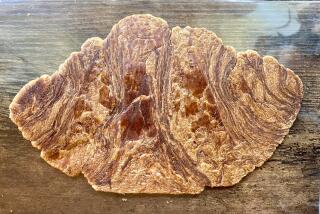Craving chocolate? Activity in certain brain area might be why.
Scientists have discovered a brain area that helps control your desire to eat sweet, hyper-palatable foods like chocolate.
The area, part of a larger brain region called the striatum, had previously been primarily linked to the control of physical movement.
The new research, published this week in the journal Current Biology and carried out in rats, adds the piece of neuronal turf to a growing list of areas whose function can best be described as, “Oooh, I want some of that!”
The scientists, from the University of Michigan, studied the area because there were some hints that it might be involved in reward-seeking behavior, specifically in encoding just how rewarding something should feel. So the scientists decided to see what would happen if they infused the area with a synthetic version of the endorphin enkephalin, which acts naturally in the region, while letting rats eat as much as they wanted of an experimental substance you might have heard of: M&M; chocolates.
It turned out that when the researchers infused that specific area with enkephalin -- whose most well-known function is as a pain-relieving peptide -- the rats suddenly upped their intake of chocolate by more than double. And when they took another group of rats and measured the levels of naturally-occurring enkephalin in the area, they found that M&M; consumption led to an immediate increase in enkephalin.
And the more enkephalin they detected in the region, the faster the rat ate.
But the experiments still did not answer a fundamental question: Was the area involved in making the rats want the chocolate more, or did adding enkephalin suddenly make the chocolate taste better?
To answer that question, they turned to a rather odd experimental protocol: They studied the rats’ faces while they ate. If the rats did things like lick their lips more when there was more enkephalin in the area, that would suggest the chocolate actually tasted better. But instead, their facial expressions were the same, meaning the change could probably be chalked up to increased motivation.
The finding fits with some compelling previous research showing that restoring function to the area could get a mutant mouse with no appetite to feed again. But it’s worth noting that the area -- like all parts of the brain -- does not act alone. Instead, it exists within a circuit, receiving input from other parts of the brain that also play a role in controlling reward and motivation.
And this circuit probably exists in parallel to other, more well-established pathways, like the one involving a region called the nucleus accumbens -- another area, situated near the dorsal striatum, that also modifies our desire to eat different foods. Both of these circuits could be potential sites for intervention in cases of addiction, whether to food or drugs, since modifying the motivation to seek out substances is crucial to addiction treatment.
These multiple pathways to consumption are the product of necessity. Our brains, and the brains of other animals as well, evolved in times of scarcity, when fatty, highly-palatable foods were hard to find and should be shoved into one’s face with wild abandon when present. That may not be the world we live in today, but evolution is slow to catch up.
In this context, it should come as no surprise that our brains are triple, maybe even quadruple booby-trapped to want that last M&M; really, really badly.
You can read a summary of the chocolate study here.
Return to the Science Now blog.






